The X Button
Hard Truths
by Todd Ciolek,
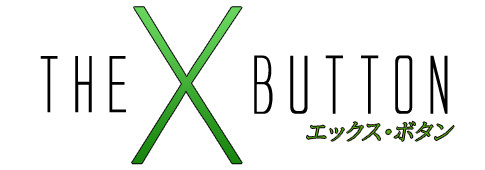
Last week, I complained that North America wasn't getting any special edition of Final Fantasy XIII. Well, Square fixed that, because there's now a special edition. And it's an Xbox 360!

This Final Fantasy XIII system looks just like any other Xbox 360 at a glance, but it has one special feature: the words “Final Fantasy XIII” engraved on its hard drive. You also get two controllers (for the two-player mode that the game doesn't have) and box art of Lightning looking dazedly at a giant game system. Slightly less dull are this package's exclusive Xbox Live avatar accessories: the outfits of Rosch and Nabbat, plus a baby chocobo pet.
Square Enix's press release also mentions a special Xbox 360 faceplate designed by Tetsuya Nomura. It'll be available as a promotion in “very limited numbers,” so I suggest going down to your local game store and asking for one right now. And if they say they don't have any, then they are lying to you.
NEWS
DEAD RISING 2 SHOWS XBOX 360 BIAS
Dead Rising 2 will hit the Xbox 360, the PC, and the PlayStation 3 all at once, but the Xbox 360, as it stands, will be the only system that gets a playable prologue for the game. Entitled Case Zero, it'll be available on Xbox Live shortly before the full game's August 31 release date, and it'll presumably explain why some guy named Chuck Greene is fending off hordes of zombies in place of Dead Rising hero Frank West. Case Zero apparently won't be available on the PC or PS3, but Capcom may relent if people complain. And complain they will.

Then again, everything in Dead Rising 2 may well be overshadowed by the fact that Chuck can make a double-bladed polearm out of a canoe paddle and two chainsaws.
ESPGALUDA II REGION-FREE, MOSTLY
Today's game-playing youngsters are spoiled when it comes to imports. The majority of Japanese games worth playing are snapped up and localized by American publishers, and few native English speakers, beyond the horribly impatient, need to pay for importing titles. Every now and then, however, an import gets a cult following without actually coming to North America. Cave's Xbox 360 release of Mushihime-Sama Futari was last year's big standout, as all sorts of shooter fans paid upwards of $75 for the game. And Cave made it easy by launching Mushihime-Sama Futari without any region locking.

Cave's done the same thing for ESPgaluda II, an awesome vertical shooter that'll be region-free when it hits the Japanese Xbox 360 next week. Well, the regular edition will be region-free, at least. The special edition, with its bonus faceplate, will be coded strictly for Japanese systems. Still, the regular edition has a two-disc soundtrack packed in, which is something often reserved for special editions.
All of this would suggest that Cave doesn't plan to bring ESPgaluda II to North America, though Aksys Games recently broke new ground by licensing Cave's Deathsmiles shooter for a U.S. release. Even if ESPgaluda II stays in Japan, anyone who wants the game won't have much trouble importing it.
FULLMETAL ALCHEMIST RPG ANNOUNCED
Is Fullmetal Alchemist still hugely popular in North America? The new Brotherhood series is airing on cable now, but everyone knows that the true test of an anime series lies in how many games publishers bring over. So far, no one's bit on the PSP fighter or the Wii adventure game, but Namco Bandai has a new Fullmetal Alchemist title in the works. Subtitled To the Promised Day, it's an RPG for the PSP. That's all we know about it so far, but you might see it on these shores if the kids really like Fullmetal Alchemist a second time around.
REVIEW: ACE ATTORNEY INVESTIGATIONS: MILES EDGEWORTH
 Developer: Capcom
Developer: Capcom
Publisher: Capcom
Platform: DS
Players: 1
MSRP: $29.99
The Phoenix Wright games are unique in the modern gaming industry, and not just because they're legal thrillers with lots of conversations and simple interfaces. They're also the sort of slow-paced, anime-esque game that's supposed to drive away Western customers and publishers. Yet Capcom took a chance on the first Phoenix Wright: Ace Attorney, and it's grown into a cult success with sequels, domestically released manga, and an Ace Attorney Investigations spin-off starring Phoenix's rival, the stuffy and impeccably groomed prosecutor Miles Edgeworth.
Ace Attorney Investigations, like the other Phoenix Wright games, is driven largely by its dialogue, whether it involves a lawyer and a suspect, a witness and a detective, or a condescending attorney and a thieving young woman with a key in her hair. Edgeworth, constantly called upon to investigate murders and ensnare the culprits, spends most of his time poking around crime scenes and questioning the invariably weird suspects connected to each case. It's all in the vein of old-fashioned adventure games, carried off with lots of colorful writing and large, fully animated characters.
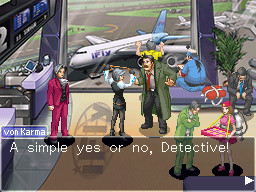 Yet Ace Attorney Investigations makes a few minor changes. In a move that brings the game even closer to the point-and-click adventures of old, Edgeworth can walk around the scenery, examining various items and talking to other characters; a minor alternation, but it's strangely fun to see the Phoenix Wright cast nosing around like they're in a Monkey Island game. Edgeworth's legal habits also give him a “logic” command that links two clues together, moving the plot forward with some small revelation. Each failure in Edgeworth's investigation, whether it's a pointless question or a bizarre leap of logic, depletes a meter. When it's empty, some innocent soul is presumably condemned to the Japanese police system and its manifold human-rights abuses.
Yet Ace Attorney Investigations makes a few minor changes. In a move that brings the game even closer to the point-and-click adventures of old, Edgeworth can walk around the scenery, examining various items and talking to other characters; a minor alternation, but it's strangely fun to see the Phoenix Wright cast nosing around like they're in a Monkey Island game. Edgeworth's legal habits also give him a “logic” command that links two clues together, moving the plot forward with some small revelation. Each failure in Edgeworth's investigation, whether it's a pointless question or a bizarre leap of logic, depletes a meter. When it's empty, some innocent soul is presumably condemned to the Japanese police system and its manifold human-rights abuses.
Edgeworth's various cases prove as outlandish as previous Phoenix Wright crimes, and Capcom uses the new visual style to stage drama outside of courtrooms. Edgeworth pursues murderers on airplanes, in a theme park, and during a flashback that Capcom doesn't want reviewers to talk about too much. Each of the game's five lengthy cases is built one small step at a time, with Edgeworth gradually chipping away at the testimonies of inept witnesses and duplicitous criminals. It's linear play, with solutions often being a mere matter of walking around until you stumble on the right clue. It's also a bit frustrating when Edgeworth, genius prosecutor that he is, has to steadily reason out an answer just because the game demands that method.
 But let's be honest: Phoenix Wright games are not about intricate action or replayable game design. They're about the characters, the ridiculous and charming denizens of a world where flight attendants can legally detain people and even murderers are amusing goofballs. And Edgeworth's game carries itself superbly in that regard. The Phoenix Wright titles cast him as a smug, unerring egotist who had to be deflated by Phoenix's legal triumphs, and Ace Attorney Investigations plays on the same idea in a different way. Edgeworth still looks down on everyone, but he's genuinely likeable when the player gets inside him, and it makes his victories all the more satisfying.
But let's be honest: Phoenix Wright games are not about intricate action or replayable game design. They're about the characters, the ridiculous and charming denizens of a world where flight attendants can legally detain people and even murderers are amusing goofballs. And Edgeworth's game carries itself superbly in that regard. The Phoenix Wright titles cast him as a smug, unerring egotist who had to be deflated by Phoenix's legal triumphs, and Ace Attorney Investigations plays on the same idea in a different way. Edgeworth still looks down on everyone, but he's genuinely likeable when the player gets inside him, and it makes his victories all the more satisfying.
It's also entertaining to see the constantly snide Edgeworth as the straight man to a lineup of nutcases. His immediate sidekick is the obsessively devoted detective Dick Gumshoe, who's even more of an endearing lunk when paired with Edgeworth. Newer characters reveal themselves throughout the game, with exuberant thief Kay Faraday playing off the subdued Edgeworth quite well. Investigator Shi-Long Lang and his reticent secretary don't make as big of a splash when positioned as Edgeworth's rivals, but perhaps that's because the game begs for Edgeworth to face off against Phoenix Wright himself in court. Too bad Capcom wouldn't let that happen.
The translation is mostly competent, and the script beneath it is frequently amusing, giving even disposable characters memorable impact. The dialogue carries everything surprisingly well without any voice acting (the inclusion of which might actually ruin things for longtime fans at this point) or a memorable soundtrack.
Ace Attorney Investigations may not force major changes upon the Phoenix Wright standards, but it has the same eccentric appeal. Even if there's not much reason to return to it once finished, one play through it is reward enough. It's a fine addition to the series, so much so that I'd prefer a second Miles Edgeworth game to another title starring a goody-goody defense lawyer.
RELEASES FOR THE WEEK OF 2-21
LAST REBELLION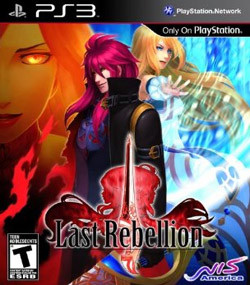 Developer: NIS/Hit Maker
Developer: NIS/Hit MakerPublisher: NIS America Platform: PlayStation 3 Players: 1 MSRP: $49.99
Last Rebellion's trip to North America was quite short, as it arrived in Japan less than a month ago. Then again, it also scored fairly low with Japanese game magazine Famitsu (shocking, considering how
|
METAL SLUG XX Developer: SNK Playmore
Developer: SNK PlaymorePublisher: Atlus Platform: PSP Players: 1-2 MSRP: $19.99 (plus 99 cents for Leona)
Metal Slug 7 was not well-received on the DS, as many found it lacking in the visual panache and two-player mayhem of the best of SNK's cartoony, side-scrolling war shooters. Yet I am confident that the PSP version, renamed Metal Slug XX, will improve on things. Why? Because it has a playable Leona Heidern, the blue-haired commando from The King of Fighters. Once bought from the PlayStation Store, she can slash and jump quickly through all sorts of colorful Metal Slug carnage. Oh yeah, and the PSP version of Metal Slug XX also has an ad-hoc two-player mode, and that helps quite a bit. Other highlights include 70 missions in the game's combat school, which, if it's anything like the DS version, will involve the player's commanding officer Cynthia flirting more and more with each completed mission.
|
SONIC & SEGA ALL-STARS RACING Developer: Sega
Developer: SegaPublisher: Sega Platform: Wii/PS3/Xbox 360 Players: 1-4 MSRP: $39.99 (Wii), $49.99 (PS3, Xbox 360)
Sega's All-Stars cart racers, tennis tournaments, and party games often strike me as missed opportunities. If you're going to put popular Sega characters in a racing game, why not choose some obscure faces, like Gunvalkyire's Kelly, the Burning Rangers, Last Bronx's Yoko, or one of the dragons from Panzer Dragoon? But no, Sega sticks with a cast of mostly familiar choices, including Space Channel 5's Ulala, Super Monkey Ball's AiAi, and, of course, plenty of Sonic characters. Granted, the game also pulls out Fantasy Zone's Opa-Opa ship, the mice from Chu-Chu Rocket, the little-loved stars of Bonanza Bros., Ryo from Shenmue (in a forklift!), and former Sega mascot Alex Kidd, so perhaps that counts for something. Anyway, the game's a racer in the Mario Kart mold, complete with power-ups and courses outfitted with numerous Sega references.
|
EXTRA LIVES: PROJECT: HORNED OWL
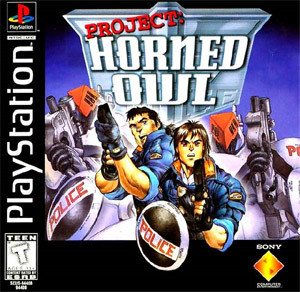 What's the most disappointing thing to involve manga author Masamune Shirow? Gundress, Landlock, and Ghost in the Shell 2: Man-Machine Interface are all good and defensible answers, yet there's another one lying back in the PlayStation's early days. Shortly after the console proved a success in Japan, Sony needed something to compete with Sega's Virtua Cop series. So Sony hired Alfa System to program a light-gun shooter, Konami to create a futuristic plastic pistol, and Masamune Shirow to design characters for the game. And Sony called it Project: Horned Owl.
What's the most disappointing thing to involve manga author Masamune Shirow? Gundress, Landlock, and Ghost in the Shell 2: Man-Machine Interface are all good and defensible answers, yet there's another one lying back in the PlayStation's early days. Shortly after the console proved a success in Japan, Sony needed something to compete with Sega's Virtua Cop series. So Sony hired Alfa System to program a light-gun shooter, Konami to create a futuristic plastic pistol, and Masamune Shirow to design characters for the game. And Sony called it Project: Horned Owl.
Shirow didn't try anything new with his contribution, sticking with the same police mecha and hard-nosed cops that fill many of his manga series. Indeed, Project: Horned Owl is warmed-over Appleseed, set in a near-future city threatened by a bunch of cyborg terrorists called Metallica (how that got by the lawyers we may never know). Officers Nash Stolar and Hiro Utsumi take on various robotic threats, supported by plot exposition from their bespectacled commander Kate. The three of them carry out a raid on a heavily armed corporate headquarters, a chase through a sewer, an escape from a booby-trapped terrorist base, and other things that should be entertaining in a competent light-gun shooter.
However, Project: Horned Owl is not a competent light-gun shooter. It is, in fact, one of the dullest light-gun shooters ever created. Weapons consist of screen-clearing grenades and an endlessly reloadable gun that can fire single bullets or, when the trigger is held down, release a shotgun-like burst. There are no power-ups, no additional weapons, and not much to shoot at beyond the tired enemies and the occasional civilians, the latter of whom scream despite being apparently bulletproof.
 The game makes everything worse by slowing down all the time. Light-gun shooters need a rapid pace to sell themselves in the arcades, but Project: Horned Owl was made for the PlayStation, and Alfa System wanted to take things easier. Nash and Hiro's police mecha fly lazily through city streets and corridors, with plenty of pauses in the action. Far too much of the game is spent watching your first-person perspective pan across the scenery, while you take in the banal story and wish you had something to shoot.
The game makes everything worse by slowing down all the time. Light-gun shooters need a rapid pace to sell themselves in the arcades, but Project: Horned Owl was made for the PlayStation, and Alfa System wanted to take things easier. Nash and Hiro's police mecha fly lazily through city streets and corridors, with plenty of pauses in the action. Far too much of the game is spent watching your first-person perspective pan across the scenery, while you take in the banal story and wish you had something to shoot.
Shooting things doesn't help too much, because Project: Horned Owl is the sort of game that's boring even when it's hard. It tries to look halfway interesting, with 3-D environments and simple, sprite-based mechanized enemies, but the backgrounds are bland and the enemies are all unremarkable robots. The worst are the Zaku-like green mecha that pop up over and over throughout the game, always attacking the same way. The bosses add little, as they're mostly ugly machines that seldom stick around for long.
Along with Shirow's artwork, Sony paid Movic to animate parts of Project: Horned Owl, resulting in brief, pointless little cutscenes between stages. The plot is generic police-against-terrorism pulp, and the animation is rarely dynamic. The same goes for the in-game dialogue; Nash and Hiro are hard to tell apart, and Kate is a constantly babbling source of drab backstories. It comes to an embarrassing apex in the third level, where a descent into the sewers is accompanied by one of the officers remarking, “Smells like my wife's cooking!” Oh, Nash, you card. Or was that Hiro? Eh, I don't care.
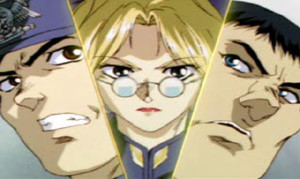 At least something good came of Project: Horned Owl: a barely related follow-up called Elemental Gearbolt. Alfa System learned a few things from their first light-gun game, and used the lessons to make a far more atmospheric anime-fantasy shooter. Elemental Gearbolt still has some strangely quiet moments, but it's greatly improved by a rushing soundtrack and a visual style influenced by the Panzer Dragoon games. But enough about that.
At least something good came of Project: Horned Owl: a barely related follow-up called Elemental Gearbolt. Alfa System learned a few things from their first light-gun game, and used the lessons to make a far more atmospheric anime-fantasy shooter. Elemental Gearbolt still has some strangely quiet moments, but it's greatly improved by a rushing soundtrack and a visual style influenced by the Panzer Dragoon games. But enough about that.
Project: Horned Owl's Japanese release, known simply as Horned Owl was lavish for its day, as it was packed in a box set with Konami's Hyperblaster gun (in uncensored dark blue) and a manual full of illustrations from Shirow, who apparently designed even the game's player-energy meter. Sony's North American version was far less extravagant, as the game was quietly released on its own, retaining the Shirow-drawn cover art. Players had to supply their own light guns (in day-glo American colors, of course), which means that some poor souls paid at least $70 to play Project: Horned Owl back in 1996.
Project: Horned Owl isn't as spectacularly bad as some other Shirow-related blunders. It's just a banal misstep that rarely inspires one to keeping playing. Fans of Shirow or game guns may want this to complete a collection, but some passable art and a plastic pistol are all that Project: Horned Owl really has to offer.
While somewhat obscure among PlayStation releases, Project: Horned Owl is in low demand, with copies available for under ten bucks. The Japanese box set with the Hyperblaster is harder to find, though it isn't too expensive.
discuss this in the forum (32 posts) |
this article has been modified since it was originally posted; see change history